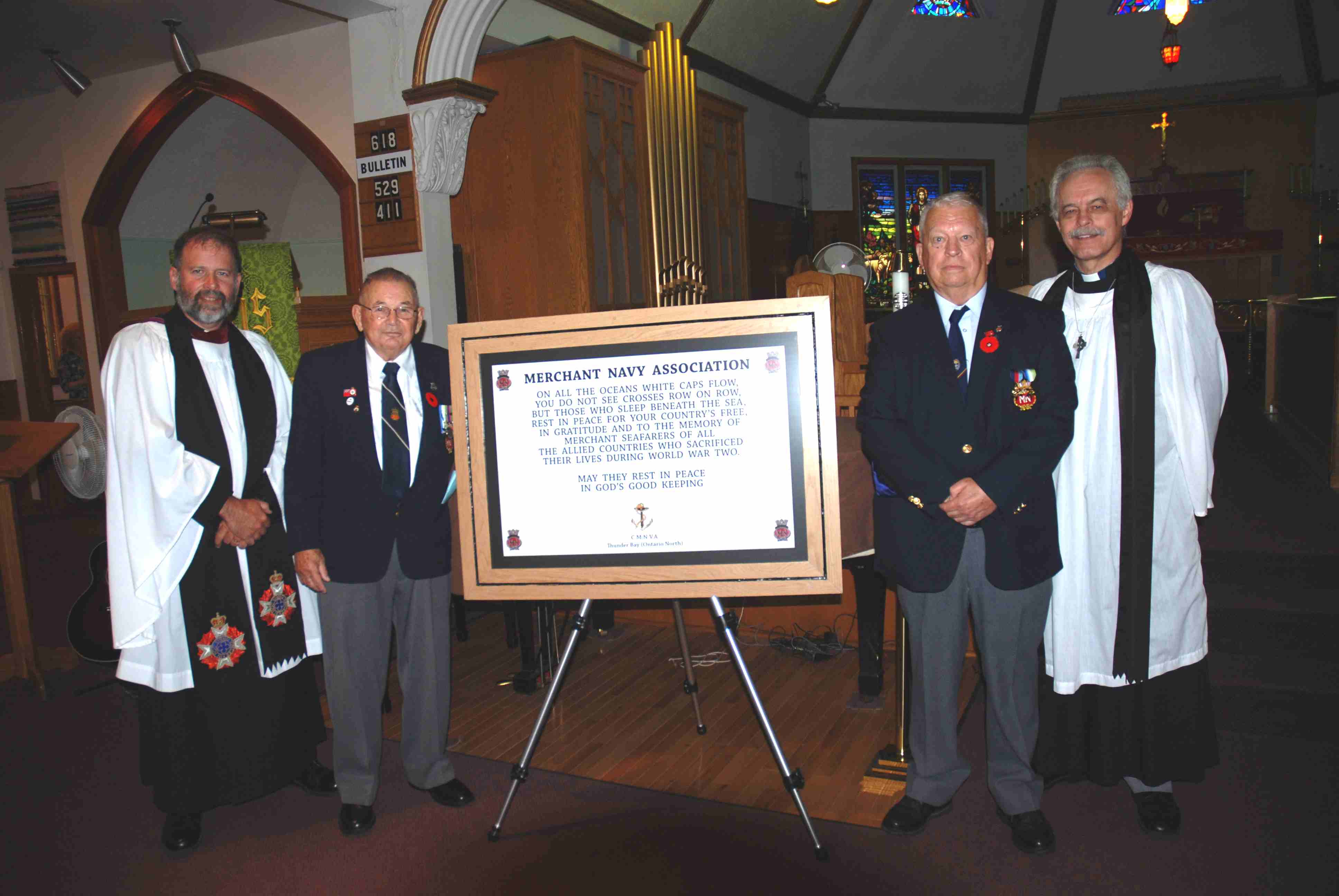
The Mission to Seafarers: Port of Thunder Bay
Lest
We Forget
Updated September 2008
Lest We Forget is a phrase that calls us to remember. We remember for the sake of the past, present and future. We remember the past to honour the sacrifice made and to appreciate how we have benefited from that sacrifice. We remember for the sake of the present because the past sacrifice informs us as we make decisions about the conduct of our international relations and what it means to send our people to war. We remember for the sake of the future so that we can make sound decisions that will prevent the seeds of conflict from being planted. Remembrance Day and memorial services such as the Merchant Navy Day on September 3 and the Battle of the Atlantic Sunday on the first Sunday in May help us to remember.
The merchant navy was always involved in warfare. Before dedicated warships were built, merchant ships had to defend themselves and were conscripted as warships as required. As they lost the ability to defend themselves, they became vulnerable; they were targets. Food, fuel, war material and troops are essential for the conduct of war. Strategic warfare developed to deny your enemy these supplies and ensure that your supplies got through. With 95% of global trade going by sea, merchant ships are potential targets. We should not forget that warfare means that the people who crew these ships and their families will make sacrifices in time of war.
See also Sailor's Memorial Park, a Thunder Bay memorial to sailors of N. M. Paterson. Ltd who lost their lives in World War 2.

Dedication of Memorial Plaque
prepared by the Canadian Merchant Navy Veterans Association of Thunder Bay
at St. Thomas Anglican Church September 14, 2008
The plaque was patterned after the one in the Anglican Cathedral in Valletta, Malta, which was dedicated by Queen Elizabeth II, is installed in the memorial corner of St. Thomas' Anglican Church in Thunder Bay.
The Commemoration of the
Battle of the Atlantic
in Thunder Bay
First Sunday in
May
|
Each year in Thunder Bay ships are loaded with grain bound for Europe. During WW 2 ships like these headed for Halifax. There they formed into convoys to run the gauntlet of submarines and aircraft, which hunted them, as they steamed towards ports in the UK. These ships carried the necessities of life: grain, bacon, sugar, dairy products, and gasoline as well as people, aircraft and armaments to fight the war. Canadian and allied merchant ships made 25,000 voyages and delivered 180 million tons of vital cargo. 2,603 merchant ships were sunk of which 62 were Canadian. 1466 Canadian merchant seafarers were killed.
Merchant seamen and navy men, survivors of two torpedoings reach St. John's, Nfld., in September 1942. In the winter that followed merchant seamen again earned the navy's admiration.
The ships lost by the Royal Canadian Navy in the Battle of the Atlantic: FRASER, BRAS D'OR, MARGAREE, OTTER, LEVIS, WINDFLOWER, SPIKENARD, RACOON, OTTAWA, LOUISBOURG, WEYBURN, ST. CROIX, CHEDABUCTO, ATHABASKAN, VALLEYFIELD, ESQUIMALT, REGINA, ALBERNI, SKEENA, SHAWINIGAN, CLAYOQUOT, TRENTONIAN, GUYSBOROUGH, CHARLOTTETOWN, and MTB 459, 460, 462, 263, 465, and 466. and those lost by the Canadian Merchant Navy: Erik Boye, Magog, Waterloo, Kenordoc, St. Malo, Trevisa, Maplecourt, Canadian Cruiser, A.D.Huff, J.B.White, Canadolite, Portadoc, Europa, Collingdoc, Vancouver Island, Shinai, Lady Hawkins, Montrolite, Empress of Asia, Victolite, George L. Torian, Lennox, Sarniadoc, Robert M. Ponerov, Vineland, James E. Newsom, Lady Drake, Mont Louis, Calcarolite, Torondoc, Troisdoc, Frank B. Baird, Liverpool Packet, Lucille H., Prescodoc, Fort St. Nickolas, Princess Marguerite, Donald Stewart, Lord A. Holloway, Oakton, Norfolk, Carolus, Bic Island, Rosecastle, Chr. J. Kampmann, Angelus, Jasper Park, Watuka, Albert C. Field, Cornwallis, Point Pleasant Park, Soreldoc, Taber Park, Avondale Park, Fort Missanabie, Port Norfolk, Fort Maisonneuve, R.J. Cullen, and Lady Somers. See longer article Battle of the Atlantic |
Canadian and allied navies escorted these ships while listening for the ping of a submarine on their asdic sets (sonar). When it was heard, the hunt began. The main enemy was the sea. Convoys did not have the peacetime luxury of avoiding stormy weather. The rolling waves and howling wind took its toll. Ice formation on the ship's upper works, unless chopped off would capsize a ship. 175 Allied warships were sunk of which 24 were Canadian. 2024 Royal Canadian Navy (RCN) personnel gave their lives. 632 U-boats were sunk and the German navy lost 28,000 men at sea. Canada's navy grew from 4,000 personnel to nearly 100,000 by war's end, ending the war as the 3rd largest allied navy. Here in Thunder Bay the Port Arthur Shipyard built many vessels for the war effort. N.M. Paterson Ltd. ships carried cargo and 8 were sunk.
|
|
|
The Battle of Atlantic helps us remember:
Pictures taken at the May 4, 2008 Battle of the Atlantic
Commemoration |
||